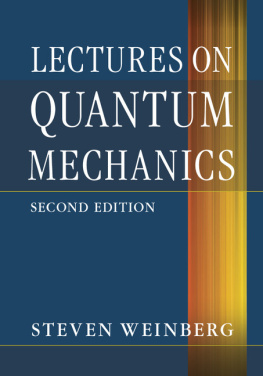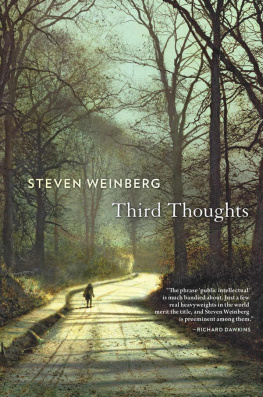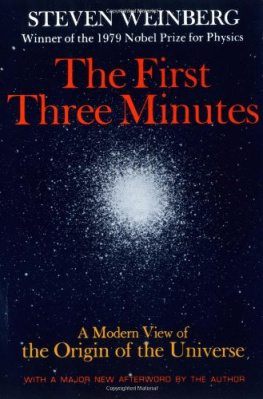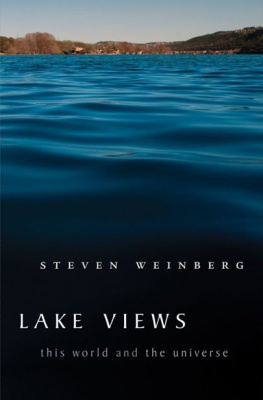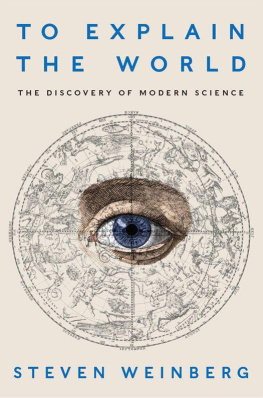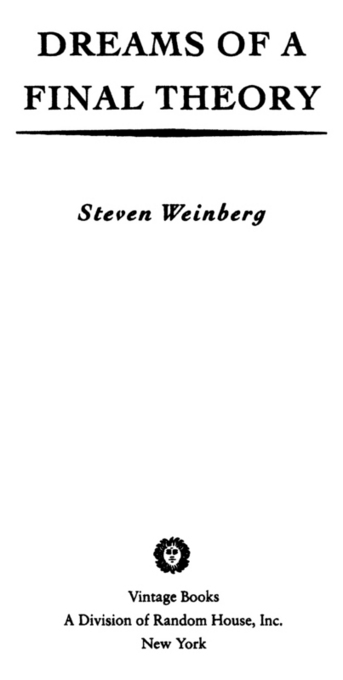ACCLAIM FOR Steven Weinbergs

DREAMS OF A FINAL THEORY
Weinberg challenges the reader with the puzzling ability of the human mind to anticipate natures secrets, and offers stunning examples of predictions that turned out to be true. He reflects upon what it means to say that a theory is beautiful, and why beautiful theories are likely to work. And he explains with remarkable lucidity why the search for fundamental laws has reached an impasse.
Chet Raymo, Los Angeles Times
Steven Weinberg, one of the world's leading theoretical physicists, displays a degree of intellectual frankness that borders on aggression. In his new book he tackles a variety of difficult and controversial issues on the periphery of elementary particle physics and presents his personal conclusions in fresh, powerful language.
Hans Christian von Baeyer, Boston Globe
In this book, the narrative, background, and authors case for his own theories and conclusions are intermingled in a manner that the general reader can comprehend and enjoy.
Science News
It is a wonderful book. It is a provocative book. In the recent spate of books by Nobel laureate physicists, it is the best.
Boston Globe
I studied no science of any kind after tenth-grade chemistry. One of the virtues of Weinbergs book is that it is able to communicate to a scientific ignoramus, and does so because of the [qualities of] detachment, patience, and clarity, organically connected by deep commitment to the subject. As it happens, for Weinberg beauty of an objective sort is central to his commitment.
Mindy Aloof, Atlantic Monthly
Dreams of a Final Theory is a good book and an honest one.
Phillip Johnson, Wall Street Journal
He moves beyond the simplistic description of experimenters doing their job to prove or disprove theories to give us a much richer picture of how science actually works.
Jon Van, Chicago Tribune
The physics world is bound to have high expectations for a new book by Steven Weinberg, one of its most distinguished citizens. Dreams of a Final Theory does not disappoint. I came away from a first reading of the book eager to read it again. A second reading left me mightily impressed with its subtlety and honesty. Dreams of a Final Theory deserves to be read and reread by thoughtful physicists, philosophers, and just plain thoughtful people.
Frank Wilczek, Physics Today
A compelling plea for seeking the final laws of nature.
Sharon Begley, Newsweek
He writes clearly and with confidence, imbuing the reader with an irresistible sense that one is in the hands of a master physicist at play.
Michael White, Sunday Times (London)
Steven Weinberg

DREAMS OF A FINAL THEORY
Steven Weinberg received the 1979 Nobel Prize for Physics for his work in unifying two of the fundamental forces of nature, and in 1991 he was awarded the National Medal of Science at the White House. His earlier prize-winning book The First Three Minutes is the classic account of the Big Bang, the modern theory of the origin of the universe. Among his other books are The Theory of Subatomic Particles and Gravitation and Cosmology: Principles and Applications of the General Theory of Relativity. Steven Weinberg is a member of the Royal Society of London as well as the U.S. National Academy of Sciences, and has been awarded numerous honorary degrees, most recently from Columbia University and the Universities of Salamanca and Padua.
Also by
Steven Weinberg
The First Three Minutes
The Discovery of Subatomic Particles
Elementary Particles and the Laws of Physics (with Richard Feynman)
Gravitation and Cosmology
FIRST VINTAGE BOOKS EDITION, JANUARY 1994
Copyright 1992, 1993 by Steven Weinberg
All rights reserved under International and Pan-American Copyright Conventions. Published in the United States by Vintage Books, a division of Random House, Inc., New York, and simultaneously in Canada by Random House of Canada Limited, Toronto. Originally published in hardcover in slightly different form by Pantheon Books, a division of Random House, Inc., New York, in 1992.
Grateful acknowledgment is made to the following for permission to reprint previously published material:
Bourne Co. Music Publishers: Excerpt from You and I by Meredith Willson. Copyright 1941 by Bourne Co. Copyright renewed. All rights reserved. International copyright secured. Reprinted by permission.
Harcourt Brace Jovanovich, Inc.: Excerpt from East Coker from Four Quartets by T.S. Eliot. Copyright 1943 by T.S. Eliot and renewed 1971 by Esme Valerie Eliot. Reprinted by permission of Harcourt Brace Jovanovich, Inc. Rights outside of the United States administered by Faber and Faber Ltd.
Sony Music Publishing: Excerpt from the song lyrics Mammas Dont Let Your Babies Grow Up To Be Cowboys by Ed Bruce and Patsy Bruce. Copyright 1975 by Tree Publishing Co., Inc. All rights administered by Sony Music Publishing, 8 Music Square West, Nashville, Tennessee 37203. All rights reserved. Reprinted by permission.
Warner/Chappell Music, Inc.: Excerpt from the song lyrics Twentieth Century Blues by Nol Coward. Copyright 1965 by Chappell Music Ltd. All rights reserved. Reprinted by permission.
Library of Congress Cataloging-in-Publication Data
Weinberg, Steven, 1933
Dreams of a final theory / Steven Weinberg,
p. cm.
Originally published: New York: Pantheon Books, 1992.
eISBN: 978-0-307-78786-6
1. Physics. 2. Relativity (Physics) 3. Quantum theory.
I. Title.
QC21.2.W428 194
530dc20 93-30534
v3.1
To Louise and Elizabeth

CONTENTS

AFTERWORD TO THE VINTAGE EDITION:
THE SUPER COLLIDER, ONE YEAR LATER
PREFACE

This book is about a great intellectual adventure, the search for the final laws of nature. The dream of a final theory inspires much of todays work in high-energy physics, and though we do not know what the final laws might be or how many years will pass before they are discovered, already in todays theories we think we are beginning to catch glimpses of the outlines of a final theory.
The very idea of a final theory is controversial, and the subject of intense current debate. This controversy has even reached the committee rooms of Congress; high-energy physics has become increasingly expensive, and its claims to public support hinge in part on its historical mission of uncovering the final laws.
From the beginning my intention here has been to lay out the issues raised by the idea of a final theory as part of the intellectual history of our times, for readers with no prior knowledge of physics or higher mathematics. This book does touch on the key ideas that underlie todays work at the frontier of physics. But this is not a physics textbook, and the reader will not encounter neat separate chapters here on particles, forces, symmetries, and strings. Instead I have woven the concepts of modern physics into the discussion of what we mean by a final theory and how we are going to find it. In this I have been guided by my own experience as a reader in fields, such as history, in which


